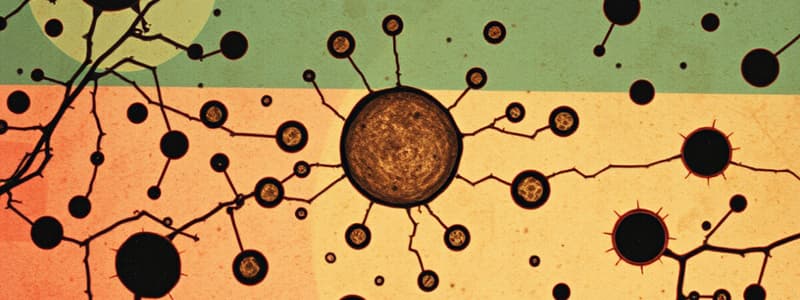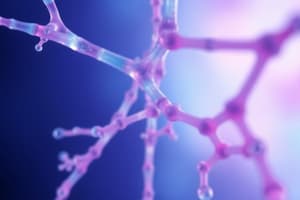Podcast
Questions and Answers
What is the basic unit of life?
What is the basic unit of life?
Cell
Which of the following cells is the largest isolated single cell?
Which of the following cells is the largest isolated single cell?
- Red blood cell
- Nerve cell
- Ovum (egg cell)
- Egg of an ostrich (correct)
Most cells are small, like nerve cells.
Most cells are small, like nerve cells.
False (B)
What shape do red blood cells typically have?
What shape do red blood cells typically have?
What is the control center of the cell?
What is the control center of the cell?
What does the fluid mosaic model describe?
What does the fluid mosaic model describe?
What is the main component of the cell wall in plants?
What is the main component of the cell wall in plants?
Which process involves the movement of substances using energy?
Which process involves the movement of substances using energy?
What is osmosis?
What is osmosis?
What happens to a cell in a hypotonic solution?
What happens to a cell in a hypotonic solution?
What is the process of taking substances from outside to inside the cell called?
What is the process of taking substances from outside to inside the cell called?
What are the two types of endocytosis?
What are the two types of endocytosis?
Human red blood cells contain a nucleus.
Human red blood cells contain a nucleus.
Flashcards are hidden until you start studying
Study Notes
Cell Overview
- Cells are the basic unit of life, smallest structural and functional unit of all living organisms.
- Microscopic in size, cells that vary in shape and size according to their function.
- Mycoplasmas are smallest cells at 0.3 µm; bacteria range from 3 to 5 µm; the largest single cell is the ostrich egg.
Shape and Size of Cells
- Cell shape includes spherical, oval, rectangular, spindle-shaped, or irregular, determined by function.
- Red blood cells (RBCs) are small and round for easy movement through blood vessels.
- Nerve cells (neurons) are long and thin to transmit signals over long distances.
Main Cell Components
- Three primary parts of a cell: cell membrane, cytoplasm, and nucleus.
Plasma Membrane
- The outer covering regulating entry and exit of substances, made up of lipids and proteins.
- Described by the fluid mosaic model, which depicts the arrangement of various components (phospholipids, proteins, cholesterol, carbohydrates).
- The phospholipid bilayer consists of hydrophilic heads attracted to water and hydrophobic tails repelled by water.
Transport Mechanisms
- Passive Transport: Movement of substances without energy expenditure, through diffusion or osmosis.
- Active Transport: Involves energy to move ions or molecules against their concentration gradient.
- Bulk Transport: Transports large molecules using vesicles, including endocytosis and exocytosis.
Passive Transport Details
- Diffusion: Movement from an area of higher concentration to one of lower concentration (e.g., CO2 and O2).
- Osmosis: Movement of water molecules across a semi-permeable membrane from higher to lower concentration.
Tonicity
- Hypotonic Solution: Lower solute concentration than the cell, leading to swelling or lysis.
- Isotonic Solution: Equal solute concentration, maintaining cell shape and size.
- Hypertonic Solution: Higher solute concentration, causing cell shrinkage (crenation).
Endocytosis and Exocytosis
- Endocytosis: Process of taking substances into the cell using vesicles; includes phagocytosis ('cell eating') and pinocytosis ('cell drinking').
- Exocytosis: Process of expelling substances from inside the cell to the outside using vesicles.
Cell Wall
- Present only in plant cells, composed of cellulose, hemicellulose, and pectin.
- Provides structure, rigidity, and mechanical strength, allowing plants to support height.
Nucleus Functions
- Control center of the cell and largest organelle in plants and animals (human RBCs lack nucleus).
- Contains chromatin fibers that consist of hereditary material; chromosomes are tightly packaged DNA.
- Surrounded by a double-layered, porous nuclear membrane that separates it from the cytoplasm.
- Nucleolus, a non-membranous structure within, is rich in proteins and RNA; site for ribosome formation.
Studying That Suits You
Use AI to generate personalized quizzes and flashcards to suit your learning preferences.




